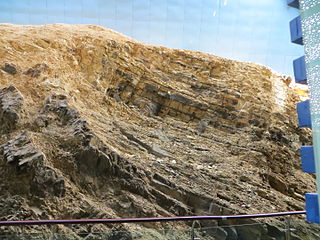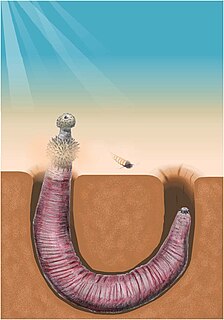
The Maotianshan Shales are a series of Early Cambrian deposits in the Chiungchussu Formation, famous for their Konservat Lagerstätten, deposits known for the exceptional preservation of fossilized organisms or traces. The Maotianshan Shales form one of some forty Cambrian fossil locations worldwide exhibiting exquisite preservation of rarely preserved, non-mineralized soft tissue, comparable to the fossils of the Burgess Shale. They take their name from Maotianshan Hill in Chengjiang County, Yunnan Province, China.
Markuelia is a genus of fossil worm-like bilaterian animals allied to Ecdysozoa and known from strata of Lower Cambrian to Lower Ordovician age containing five species.
The grand chancellor, also translated as counselor-in-chief, chancellor, chief councillor, chief minister, imperial chancellor, lieutenant chancellor and prime minister, was the highest-ranking executive official in the imperial Chinese government. The term was known by many different names throughout Chinese history, and the exact extent of the powers associated with the position fluctuated greatly, even during a particular dynasty.

Cho Tat-wah was a film actor of Hong Kong, most famous for the roles he played in a number of Wuxia films in the 1950s and 1960s.

Romance of the Three Kingdoms is a Chinese television series adapted from the classical 14th century novel of the same title by Luo Guanzhong. The series was produced by China Central Television (CCTV) and was first aired on the network in 1994. It spanned a total of 84 episodes, each approximately 45 minutes long. One of the most expensive television series produced at the time, the project was completed over four years and involved over 400,000 cast and crew members, including divisions of the People's Liberation Army from the Beijing, Nanjing and Chengdu military regions. Some of the dialogues spoken by characters were adapted directly from the novel. Extensive battle scenes, such as the battles of Guandu, Red Cliffs and Xiaoting, were also live-acted.

Parapeytoia was a prehistoric animal that lived over 530 million years ago in the Maotianshan shales of prehistoric China. It was interpreted as an anomalocaridid (radiodont) with legs, but later studies reveal it was a megacheiran, a group of arthropods which are no longer thought to be closely related to the radiodonts.

Three Kingdoms is a 2010 Chinese television series based on the events in the late Eastern Han dynasty and the Three Kingdoms period. The plot is adapted from the 14th century historical novel Romance of the Three Kingdoms and other stories about the Three Kingdoms period. Directed by Gao Xixi, the series had a budget of over 160 million RMB and took five years of pre-production work. Shooting of the series commenced in October 2008, and it was released in China in May 2010.
Sho-Saiko-To, also known as Minor Bupuleurum Formula and Xiǎocháihútāng (XCHT) in Chinese, is a herbal supplement, believed to enhance liver health. Sho-Saiko-To is a widely used prescription drug in China and is a listed formula in China and Japan as a Kampo medicine. There are currently ongoing clinical trials for Sho-Saiko-To at University of California, San Diego and Memorial Sloan-Kettering Cancer Center. The active ingredients of Sho-Saiko-To discovered so far include: Baicalin, Baicalein, Glycyrrhizin, Saikosaponins, Ginsenosides, Wogonin, Gingerol.

The Tiaojishan Formation is a geological formation in Hebei and Liaoning, People's Republic of China, dating to the middle-late Jurassic period. It is known for its fossil plants, and is made up mainly of pyroclastic rock interspersed with basic volcanic and sedimentary rocks. Previously, the Tiaojishan Formation was grouped together with the underlying Haifanggou Formation as a single "Lanqi Formation." Most researchers now agree that the Daohugou Bed, of formerly controversial dating, is a part of the Tiaojishan formation.

Archaeopriapulida is a group of priapulid-like worms known from Cambrian lagerstätte. The group is closely related to, and very similar to, the modern Priapulids. It is unclear whether it is mono- or polyphyletic. Despite a remarkable morphological similarity to their modern cousins, they fall outside of the priapulid crown group, which is not unambiguously represented in the fossil record until the Carboniferous. They are probably closely related or paraphyletic to the palaeoscolecids; the relationship between these basal worms is somewhat unresolved.

The palaeoscolecids are a group of extinct ecdysozoan worms resembling armoured priapulids. They are known from the Lower Cambrian to the late Silurian; they are mainly found as disarticulated sclerites, but are also preserved in many of the Cambrian lagerstätten. They take their name from the typifying genus Palaeoscolex.
Eolympia is interpreted as an extinct monospecific genus of sea anemone which existed in what is now Ningqiang, Shaanxi Province, China during the lower Cambrian period. Its fossils have been recovered from the Kuanchuanpu Formation. The pedicle is long, suggesting the animal engaged in sexual intercourse, though marked perforations imply that reproduction by transverse fission was also quite likely as a more primitive backup.

Mesobuthus martensii is a species of scorpion in the family Buthidae. Its common names include Chinese scorpion, Manchurian scorpion, Chinese armor-tail scorpion and Chinese golden scorpion. Despite its common name, this scorpion is not only found in Manchuria or China, but also in Mongolia and Japan. Its preferred habitat is warm, dry areas with little vegetation. M. martensii can grow to about 6 centimetres (2.4 in) long, with females usually slightly larger, and has a life-span of about 4 to 6 years.

Euornithes is a natural group which includes the most recent common ancestor of all avialans closer to modern birds than to Sinornis.

Tang Ming Huang is a Chinese television series based on historical events in the reign of Emperor Xuanzong of the Tang dynasty. The series was directed by Chen Jialin and starred Liu Wei as the eponymous emperor. It was first broadcast on CCTV-1 in 1990 in mainland China.

Heroes in Sui and Tang Dynasties is a Chinese television series based on Chu Renhuo's historical novel Sui Tang Yanyi, which romanticises the historical events leading to the fall of the Sui dynasty and the rise of the Tang dynasty. The series was first broadcast in mainland China on various television networks on 14 January 2013. It is not to be confused with Heroes of Sui and Tang Dynasties 1 & 2, a similar television series also based on the novel, but was released earlier in December 2012. Filming for the series started on 5 November 2011 at the Hengdian World Studios and wrapped up in May 2012.

The Seven Heroes and Five Gallants is a 1994 Taiwanese television series produced by Chinese Television System (CTS) a few months after its prequel Justice Pao, which was also produced by Chao Ta-shen. Dozens of actors appeared in both series, but only Sze Yu and Tu Man-sheng reprised their roles. Fan Hung-hsuan and Lung Lung chose to portray new characters rather than their iconic roles.

God of War, Zhao Yun, also known as Chinese Hero Zhao Zilong, released under the title Dynasty Warriors in Indonesia, is a 2016 Chinese television series directed by Cheng Lidong and produced by Zhejiang Yongle Entertainment Co., Ltd. The series starred cast members from mainland China, South Korea and Taiwan: Lin Gengxin, Im Yoon-ah and Kim Jeong-hoon. The story is loosely adapted from the 14th-century Chinese classical novel Romance of the Three Kingdoms, with Zhao Yun as the main character. It was first aired on Hunan TV from 3 April to 7 May 2016.

The Heart of Woman, also known as Women, is a Taiwanese Hokkien television series that began airing on SET Taiwan in Taiwan on 21 November 2012, from Mondays to Fridays, and ends on 21 November 2013, lasting one year with a total of 262 episodes.
This article records new taxa of fossil plants that are scheduled to be described during the year 2020, as well as other significant discoveries and events related to paleobotany that are scheduled to occur in the year 2020.














